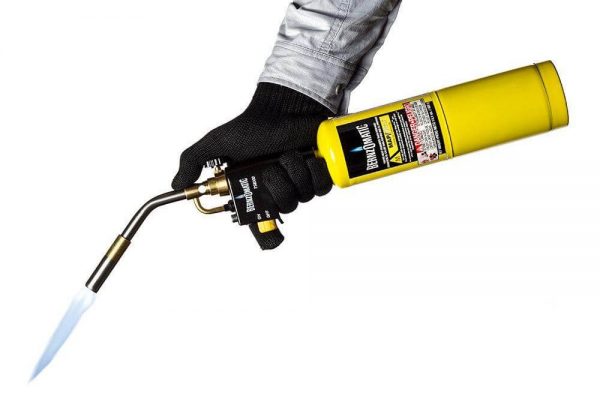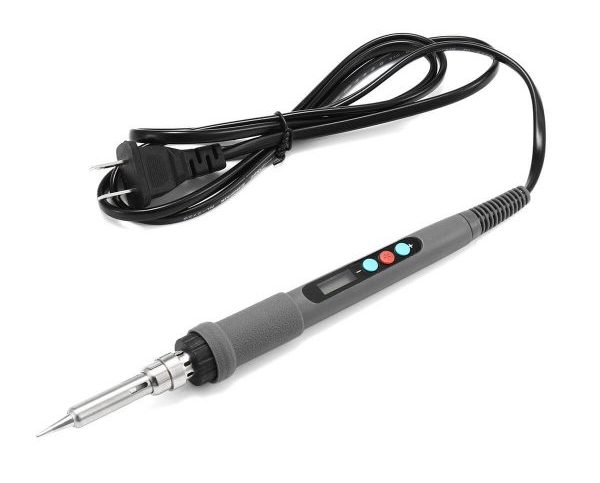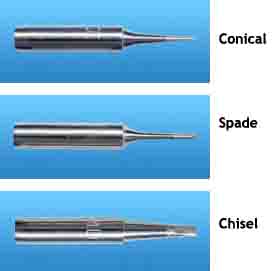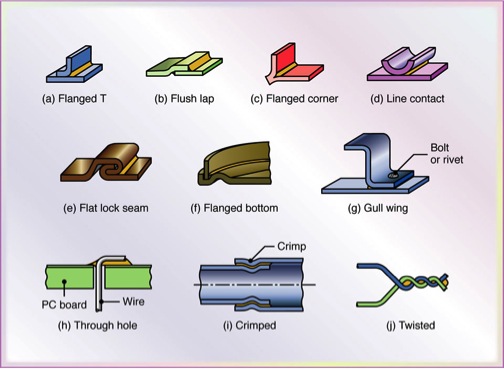Soldering is a group of processes that join metals by heating them to a suitable temperature.
A filler nonferrous metal that melts at a temperature below 840ºF (449ºC) and below that of the metals to be joined is used.
The filler metal is distributed between the closely fitted surfaces of the joint by capillary attraction.
Soldering uses fusible alloys to join metals. (Brazing occurs at temperatures above 840 Fahrenheit).
The kind of solder used depends on the metals to be joined. Hard solders are called spelter and hard soldering is called silver solder brazing.
This process gives greater strength and will stand more heat than soft solder.
Types of Soldering
- Torch soldering: soldering process using air-fuel or oxy-fuel torches. Application can be automatic or manual.
- Furnace: parts are soldered by passing them through a furnace.
- Iron
- Induction
- Resistance
- Dip (small scale process for electronic components)
- Infrared
- Ultrasonic
- Reflow or Paste
- Wave (used to attach circuits to circuit boards)
Soldering Tips
There are three types of soldering tool tips.
Soldering vs. Brazing
- Soldering: filler metals have a melting point below 840 F (450C)
- Brazing: filler metals have a melting point above 840 F (450C)
Welding refers to the fusion of two metals, while soldering and brazing use adhesion.
In soldering and brazing, the filler metal melts and flows into the joint. The base material remains intact or un-melted. The parts are fitted with tight tolerances, which produces a capillary action (capillarity) to draw the filler metal into the joint.
The advantages of brazing and soldering include:
- ability to join metals that cannot be welded. reheating can separate parts, particularly if one needs to be replaced
- easier to separate joined parts
- parts can be produced in a batch furnace
- portable process for joining smaller parts
The downside of both soldering and brazing include:
- tight joint tolerance required for capillary action
- lower strength vs. welding
- larger metal parts need to be soldered or brazed in a big furnace
- flux is required
Solder Types & Applications
| Types of Solder | Applications |
|---|---|
| Tin-lead | General Purpose |
| Tin-zinc | Aluminum |
| Lead-silver | Strength at higher than room temperature |
| Cadmium-silver | Strength at high temperatures |
| Zinc-aluminum | Aluminum, corrosion resistance |
| Tin-silver | Electronics |
| Tin-bismuth | Electronics |
Hard Soldering (cupro-techtic)
Hard soldering or silver soldering refers to solder that has silver content used to lower the melting point so that the molten metal flows more easily.
This type of soldering requires a hot heat sorce, requiring a special torch.
Oxyacetylene equipment can also be used, but there is a risk that some metals can be melted such as copper.
Hard soldering is considered to be one of the best methods for joining two copper parts.
Soft Soldering
This process is used for joining the most common metals with an alloy that melts at a temperature below that of the base metal.
In many respects, this operation is similar to brazing in that the base is not melted, but is merely tinned on the surface by the solder filler metal.
For its strength, the soldered joint depends on the penetration of the solder into the pores of the base metal surface, along with the consequent formation of a base metal-solder alloy, together with the mechanical bond between the parts.
Soft solders are used for airtight or watertight joints which are not exposed to high temperatures.
Joint Preparation
Soldered joints must snugly fit together while leaving enough of a gap for the solder.
Point to Point Soldering
The parts to be soldered should be free of all oxide, scale, oil, and dirt to ensure sound joints.
Cleaning may be performed by immersing in caustic or acid solutions, filing, scraping, using steel wool, a stainless steel brush or by sandblasting.
Wetting
Wetting refers to the ability of a liquid filler to spread over a surface (think car wax when applied to a car).
When a car has a was surface, the water beads off. In soldering, if this happens it is called poor wetting.
For this reason, the metals to be joined have to be cleaned to remove any films or oxides.
This is usually done with a flux agent.
Point to Plane Soldering
Flux
All soldering operations require a flux in order to obtain a complete bond and full strength at the joints. Fluxes clean the joint area, prevent oxidations, and increase the wetting power of the solder by decreasing its surface tension.
The following types of soft soldering fluxes are in common use:
- rosin
- rosin and glycerine.
These are used on clean joints to prevent the formation of oxides during the soldering operations. Zinc chloride and ammonium chloride may be used on tarnished surfaces to permit good tinning. A solution of zinc cut in hydrochloric (muriatic) acid is commonly used by tin workers as a flux.
Flux comes in powder, paste and liquid form. I also comes in noncorrosive and corrosive forms. The corrosive form works best, but requires a flux remover after your soldering is complete.
DO NOT USE corrosive flux on electronic projects.
Gas vs. Electric Soldering
There are 2 types of soldering tools, gas-powered and electric.
- Electric: is lightweight and often used for electronics repair.
- Gas: also know as a blowtorch, is used for projects such as copper pipes or iron. It can be used for every type of project including electronics. When soldering copper pipes we like to use MAPP gas torch, which comes in a yellow cylinder.
Gas Soldering Torch

Electric Soldering Kit

Application of Solder
Soft solder joints may be made by using gas flames, wiping, sweating the joints, or by dipping in solder baths.
Dipping is particularly applicable to the repair of radiator cores.
Electrical connections and sheet metal are soldered with a soldering iron or gun.
Wiping is a method used for joining lead pipe and also the lead jacket of underground and other lead-covered cables.
Sweated joints may be made by applying a mixture of solder powder and paste flux to the joints.
Then heat the part until this solder mixture liquifies and flows into the joints, or tin mating surfaces of members to be joined, and apply heat to complete the joint.
How to Solder
- Clean base metals with a brush or other method (see above)
- Clamp the two metals to be joined together ensuring that there is a gap for the solder. The goal is to minimize movement.
- Plug in the electric soldering iron or light the gas torch
- Heat the base material with the iron or torch
- Apply solder by touching the end of the solder to the joint. You’ll see it melt and start to flow. Continue until joint is full of solder.
- Remove soldering tool.
- Do not move soldered joint until everything has cooled.
- Use flux remover if you used a corrosive flux. If you did, after removing flux, clean joint area with water and soap.
- Wash hands.
Soldering Tips
- Clean the area to be soldered on the base metals thoroughly
- Test the joints before soldering for a good fit
- Clamp the pieces being joined to eliminate movement while soldering
- Check the required temperature needed for the solder or rods being used
- Check the table above for the right solder to use for your project. The most popular solder is 50% lead, 50% tin or 50/50. It will melt at 470F.
- Wear eye protection and do the soldering in a room with excellent ventilation.
- Use a flux, a substance that removes impurities from the air (see above explanation).

